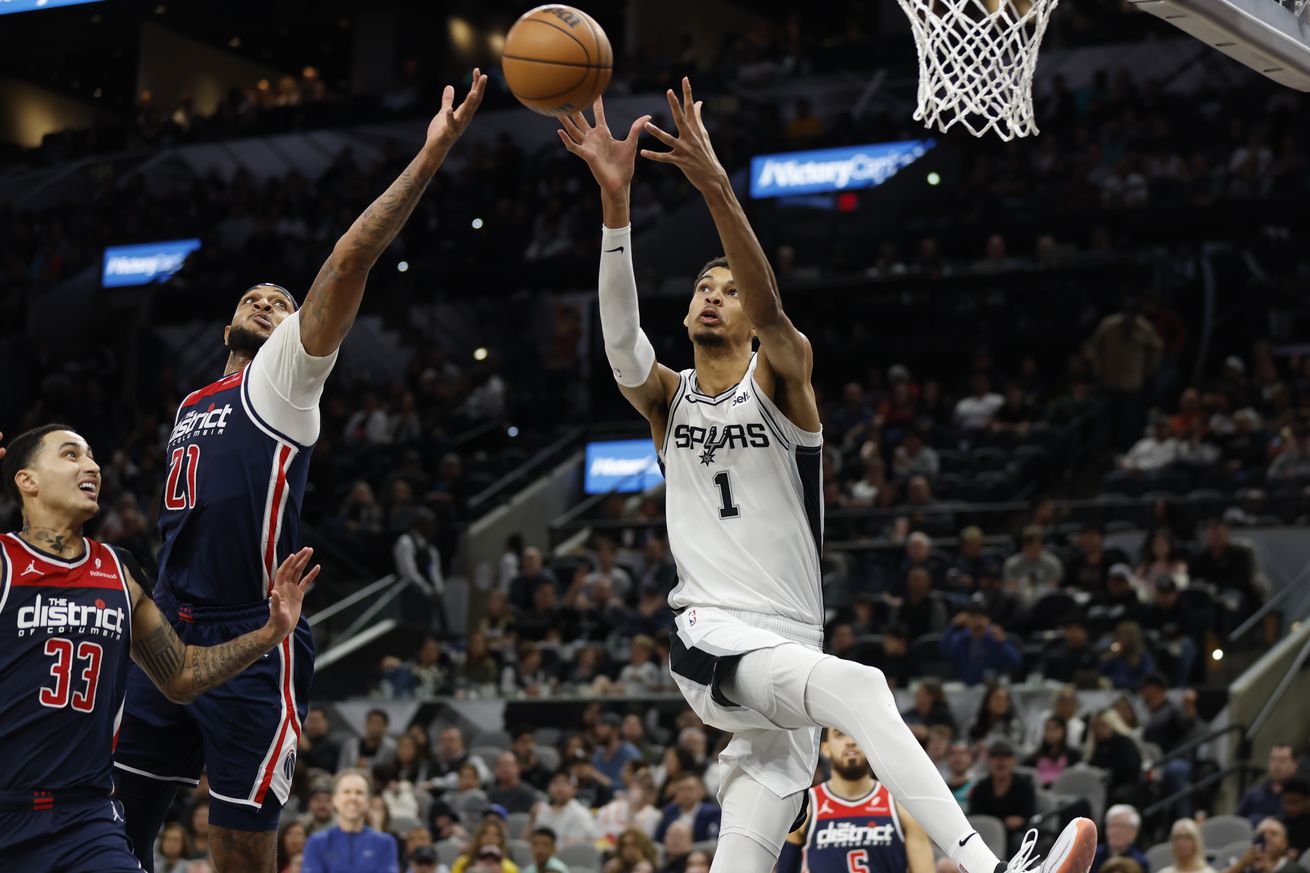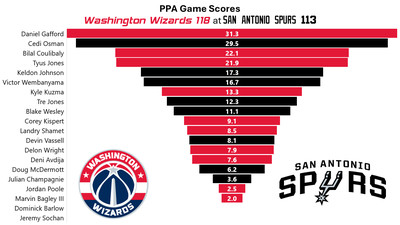
Stats, analysis, commentary.
The Wizards mounted a fourth quarter comeback that succeeded against the Spurs, and they depart San Antonio on Washington’s first winning streak of the season.
They won their second straight by getting a whale of a game from Daniel Gafford and meaningful contributions from everyone who took the floor for Washington. The Wizards had six players who scored in double digits, and on one cracked 20.
Washington won the rebounding battle by nine, and had two (Gafford and Kyle Kuzma) with more than 10 boards.
On offense, they moved the ball, producing 32 assists on 46 made field goals. Everyone who played had at least one assist.
In the second and fourth quarters, they defended. When the Wizards made their rally, they ramped up their defensive effort enough that the Spurs had trouble getting into offensive sets and shot 41.7% (effective field goal percentage) in the final period.
Interim head coach began introducing schematic wrinkles and invested a few possessions in player development. They ran inverted pick-and-rolls with guards screening for forwards, and other guards — something they’ve done rarely this season.
In the second quarter, they gave the ball to Bilal Coulibaly out top and asked him to attack. They helped him with ball screens a couple times, and he scored on a pure isolation drive. Don’t get too excited — Coulibaly largely vanished from the offense when they stopped running plays for him, and he finished the game with a 9.6% usage rate.
When I wrote that the Wizards got meaningful contributions from everyone who played, I meant it. Jordan Poole had a terrible game overall — getting stripped repeatedly by Blake Wesley when trying to bring the ball up the floor — but he also had a big defensive play on Cedi Osman late in the fourth quarter. It looked like a steal to me but got scored as a block and a rebound.
Marvin Bagley III had his worst game in a Wizards uniform (five turnovers and three fouls in 20 minutes) but also scored 15 points on six field goal attempts.
Tyus Jones thoroughly outplayed his brother (Tre Jones), especially in the fourth quarter.
Kyle Kuzma had a subpar offensive game (it took 18 shots to score 18 points), but he grabbed 11 rebounds, blocked a couple shots and scored eight points and dished two assists in the final period.
Deni Avdija had a meh night (made worse by getting elbowed in the face and ending up with a chipped tooth) but had eight rebounds and five assists.
Corey Kispert hit a couple threes, and helped on the boards and made some nice passes to teammates for buckets.
Landry Shamet had a busy 10 minutes, knocking down a pair of threes (including a sweet corner three on the move) and picking up a couple assists.
A couple other things I liked: 1) the team continued to compete after falling behind by double digits and looking for all the world like they were about to get their doors blown off, and 2) the team defensive effort against Spurs big man Victor Wembanyama.
Yes, Wembanyama had some incredible highlights. Like, he didn’t just block Gafford’s shot, he caught it as if playing against a child. Gafford, of course, is 6-10 and supremely athletic. Wembanyama just swallowed his shot. And he had one of the preposterous rebounds you’ll ever see, stretching an arm over Coulibaly to snag the ball.
And yet, Washington harassed him into 9-19 shooting and four turnovers. Wembanyama’s offensive rating (points produced per possession x 100) was just 100 on a usage rate of 33.6%. He’s been inefficient all season, but last night was another three points below his season average.
Four Factors
Below are the four factors that decide wins and losses in basketball — shooting (efg), rebounding (offensive rebounds), ball handling (turnovers), fouling (free throws made).
Stats & Metrics
Below are a few performance metrics, including the Player Production Average (PPA) Game Score. PPA is my overall production metric, which credits players for things they do that help a team win (scoring, rebounding, playmaking, defending) and dings them for things that hurt (missed shots, turnovers, bad defense, fouls).
Game Score (GmSC) converts individual production into points on the scoreboard. The scale is the same as points and reflects each player’s total contributions for the game. The lowest possible GmSC is zero.
PPA is a per possession metric designed for larger data sets. In small sample sizes, the numbers can get weird. In PPA, 100 is average, higher is better and replacement level is 45. For a single game, replacement level isn’t much use, and I reiterate the caution about small samples sometimes producing weird results.
POSS is the number of possessions each player was on the floor in this game.
ORTG = offensive rating, which is points produced per individual possessions x 100. League average last season was 114.8. Points produced is not the same as points scored. It includes the value of assists and offensive rebounds, as well as sharing credit when receiving an assist.
USG = offensive usage rate. Average is 20%.
ORTG and USG are versions of stats created by former Wizards assistant coach Dean Oliver and modified by me. ORTG is an efficiency measure that accounts for the value of shooting, offensive rebounds, assists and turnovers. USG includes shooting from the floor and free throw line, offensive rebounds, assists and turnovers.
+PTS = “Plus Points” is a measure of the points gained or lost by each player based on their efficiency in this game compared to league average efficiency on the same number of possessions. A player with an offensive rating (points produced per possession x 100) of 100 who uses 20 possessions would produce 20 points. If the league average efficiency is 114, the league — on average — would produced 22.8 points in the same 20 possessions. So, the player in this hypothetical would have a +PTS score of -2.8.
